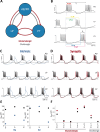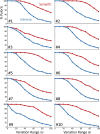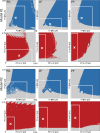Rhythmic circuit function is more robust to changes in synaptic than intrinsic conductances
- PMID: 40293432
- PMCID: PMC12037179
- DOI: 10.7554/eLife.102938
Rhythmic circuit function is more robust to changes in synaptic than intrinsic conductances
Abstract
Circuit function results from both intrinsic conductances of network neurons and the synaptic conductances that connect them. In models of neural circuits, different combinations of maximal conductances can give rise to similar activity. We compared the robustness of a neural circuit to changes in their intrinsic versus synaptic conductances. To address this, we performed a sensitivity analysis on a population of conductance-based models of the pyloric network from the crustacean stomatogastric ganglion (STG). The model network consists of three neurons with nine currents: a sodium current (Na), three potassium currents (Kd, KCa, KA), two calcium currents (CaS and CaT), a hyperpolarization-activated current (H), a non-voltage-gated leak current (leak), and a neuromodulatory current (MI). The model cells are connected by seven synapses of two types, glutamatergic and cholinergic. We produced one hundred models of the pyloric network that displayed similar activities with values of maximal conductances distributed over wide ranges. We evaluated the robustness of each model to changes in their maximal conductances. We found that individual models have different sensitivities to changes in their maximal conductances, both in their intrinsic and synaptic conductances. As expected, the models become less robust as the extent of the changes increases. Despite quantitative differences in their robustness, we found that in all cases, the model networks are more sensitive to the perturbation of their intrinsic conductances than their synaptic conductances.
Keywords: bursting neuron; neural circuit; neuronal dynamics; neuroscience; none; pacemaker; pyloric network; sensitivity analysis.
© 2024, Fournier et al.
Conflict of interest statement
ZF, LA, EM No competing interests declared
Figures






Update of
-
Rhythmic circuit function is more robust to changes in synaptic than intrinsic conductances.bioRxiv [Preprint]. 2025 Feb 5:2024.09.03.611139. doi: 10.1101/2024.09.03.611139. bioRxiv. 2025. Update in: Elife. 2025 Apr 28;13:RP102938. doi: 10.7554/eLife.102938. PMID: 39282429 Free PMC article. Updated. Preprint.
Similar articles
-
Rhythmic circuit function is more robust to changes in synaptic than intrinsic conductances.bioRxiv [Preprint]. 2025 Feb 5:2024.09.03.611139. doi: 10.1101/2024.09.03.611139. bioRxiv. 2025. Update in: Elife. 2025 Apr 28;13:RP102938. doi: 10.7554/eLife.102938. PMID: 39282429 Free PMC article. Updated. Preprint.
-
Circuit Stability to Perturbations Reveals Hidden Variability in the Balance of Intrinsic and Synaptic Conductances.J Neurosci. 2020 Apr 15;40(16):3186-3202. doi: 10.1523/JNEUROSCI.0985-19.2020. Epub 2020 Mar 16. J Neurosci. 2020. PMID: 32179572 Free PMC article.
-
Compensation for variable intrinsic neuronal excitability by circuit-synaptic interactions.J Neurosci. 2010 Jul 7;30(27):9145-56. doi: 10.1523/JNEUROSCI.0980-10.2010. J Neurosci. 2010. PMID: 20610748 Free PMC article.
-
Understanding circuit dynamics using the stomatogastric nervous system of lobsters and crabs.Annu Rev Physiol. 2007;69:291-316. doi: 10.1146/annurev.physiol.69.031905.161516. Annu Rev Physiol. 2007. PMID: 17009928 Review.
-
From conductances to neural network properties: analysis of simple circuits using the hybrid network method.Prog Biophys Mol Biol. 1995;64(2-3):201-20. doi: 10.1016/s0079-6107(96)00004-1. Prog Biophys Mol Biol. 1995. PMID: 8987384 Review. No abstract available.
References
MeSH terms
Grants and funding
LinkOut - more resources
Full Text Sources
Research Materials
Miscellaneous

